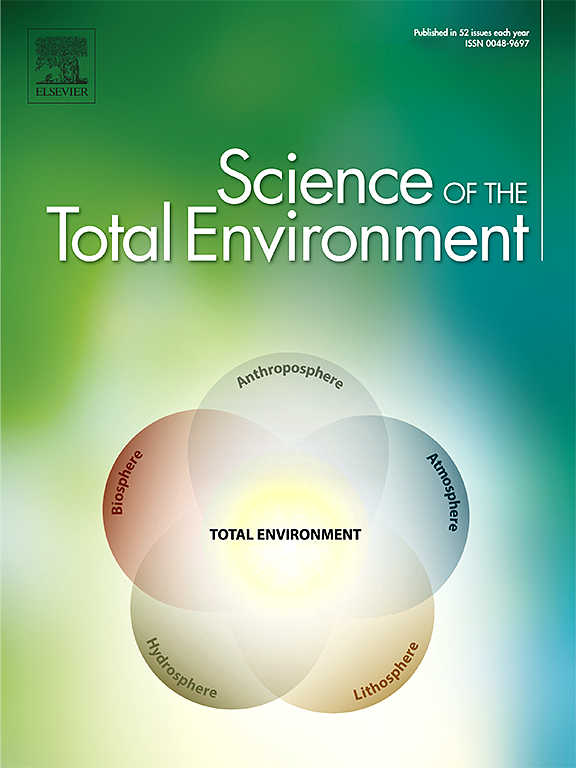揭示从红海Trichodesmium spp天然菌落富集的细菌的p溶解潜力。
IF 8.2
1区 环境科学与生态学
Q1 ENVIRONMENTAL SCIENCES
引用次数: 0
摘要
磷(P)对所有生物都至关重要,但它的可用性是有限的,特别是在海洋栖息地。在红海中丰富的重氮营养蓝藻属Trichodesmium,已被证明可以捕获和集中灰尘颗粒。虽然这种颗粒挖掘策略被认为有助于逃避营养限制,但机制背后的细节仍然难以捉摸。本研究探讨了盘根菌相关微生物群落中的溶磷细菌(PSB)及其对寄主的潜在贡献,以及它们对海洋生态系统中磷循环的可能影响。细菌在YBCII培养基上富集得到28个富集培养物,主要包括Rhodobacteraceae, Alteromonadaceae和burkholderaceae等细菌科。五种富集培养物在羟基磷灰石上进一步培养,揭示了它们消耗和释放氮和磷的能力,同时与矿物形成强烈的物理相互作用。观察到pH值下降,表明产酸是主要的p溶解途径。共培养实验证实了PSBs的存在对赤霉病菌IMS101的生长有积极的影响。这些结果表明,富集菌具有显著的P溶解活性,从而有可能提高海水中P的生物利用度。因此,PSB可能在维持红海磷平衡,支持Trichodesmium spp.和其他海洋生物的生长方面发挥重要作用。总的来说,我们的研究结果有助于更深入地了解红海的磷循环,并对开发海洋生态系统中磷管理的新策略具有启示意义。本文章由计算机程序翻译,如有差异,请以英文原文为准。

Unveiling the P-solubilizing potential of bacteria enriched from natural colonies of Red Sea Trichodesmium spp.
Phosphorus (P) is pivotal for all organisms, yet its availability is, particularly in the marine habitat, limited. Natural, puff-shaped colonies of Trichodesmium, a genus of diazotrophic cyanobacteria abundant in the Red Sea, have been demonstrated to capture and centre dust particles. While this particle mining strategy is considered to help evade nutrient limitation, details behind the mechanism remain elusive. This study explores P-solubilizing bacteria (PSB) residing within Trichodesmium's associated microbial community, their potential contribution to the host, and the possible implications for P cycling in marine ecosystems. Bacterial enrichment on YBCII medium resulted in 28 enrichment cultures, primarily comprising bacterial families such as Rhodobacteraceae, Alteromonadaceae and Burkholderiaceae. Five enrichment cultures were further grown on hydroxyapatite, revealing their ability to consume and release Nitrogen and P while forming strong physical interactions with the mineral. A drop in pH was observed, indicating acid production as the primary P-solubilizing pathway. Co-cultivation experiments confirmed a positive effect on Trichodesmium erythraeum strain IMS101 growth by the presence of putative PSBs. These results reveal that the enriched bacteria exhibit significant P-solubilizing activity, thus potentially increasing the bioavailability of P in seawater. Thus, PSB could play a vital role in maintaining the P balance in the Red Sea, supporting the growth of Trichodesmium spp. and other marine organisms. Overall, our results contribute to a deeper understanding of the P cycle in the Red Sea and have implications for developing novel strategies for P management in marine ecosystems.
求助全文
通过发布文献求助,成功后即可免费获取论文全文。
去求助
来源期刊

Science of the Total Environment
环境科学-环境科学
CiteScore
17.60
自引率
10.20%
发文量
8726
审稿时长
2.4 months
期刊介绍:
The Science of the Total Environment is an international journal dedicated to scientific research on the environment and its interaction with humanity. It covers a wide range of disciplines and seeks to publish innovative, hypothesis-driven, and impactful research that explores the entire environment, including the atmosphere, lithosphere, hydrosphere, biosphere, and anthroposphere.
The journal's updated Aims & Scope emphasizes the importance of interdisciplinary environmental research with broad impact. Priority is given to studies that advance fundamental understanding and explore the interconnectedness of multiple environmental spheres. Field studies are preferred, while laboratory experiments must demonstrate significant methodological advancements or mechanistic insights with direct relevance to the environment.
 求助内容:
求助内容: 应助结果提醒方式:
应助结果提醒方式:


